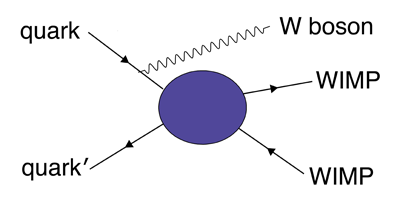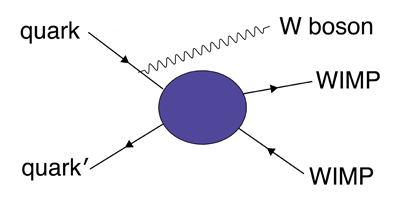Looking for the Invisible at Colliders
We have no idea what dark matter is. Most attempts to unravel the mystery entail trying to directly detect primordial dark matter particles as they stream by Earth. But it is, in principle, possible to produce dark matter particles in colliders. Until now, bounds from direct detection have been stronger than such collider searches. Now, the ATLAS collaboration at the LHC reports in Physical Review Letters that it has used the absence of a certain type of such collider production to place the strongest constraints yet on some models of dark matter.
If dark matter consists of weakly interacting massive particles (WIMPs), which couple to protons and neutrons, then these particles have some chance of scattering off nuclei in one of the many underground direct dark matter detectors. Nuclei are made of protons and neutrons, which are in turn made of quarks. Think of the process as WIMP + quark goes to WIMP + quark . Quantum field theory says that there is then some probability amplitude for the related process, quark + quark goes to WIMP + WIMP, a process that would occur at a collider. But the pair of WIMPs would fly off unseen, so how could you detect the process?
Quantum field theory also says that in a specific fraction of the events, one of the quarks will radiate a or boson before it is annihilated by the other quark and is turned into a pair of WIMPs. So ATLAS looks for events with monojets from a hadronically decaying or boson and nothing else. The data agree with standard model background effects—no sign of WIMPs. ATLAS uses the result to place bounds on certain WIMP models with spin-dependent interactions, which are more stringent than such bounds from all existing direct detection experiments. Direct detection experiments still place stronger constraints on spin-independent interactions. Thus colliders are a powerful complementary tool to direct detection experiments in the ongoing search for dark matter. – Robert Garisto





